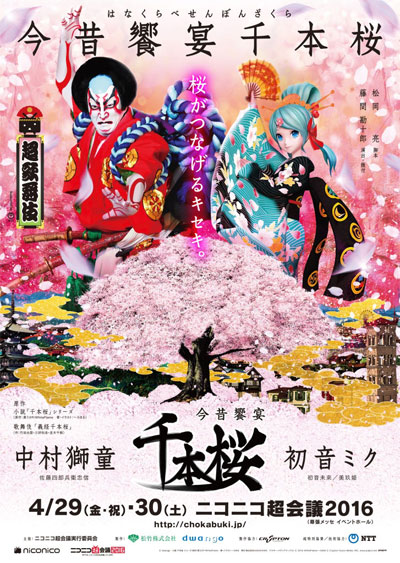| APRIL 2016 |
|
5 shows in T˘ky˘ (Kabukiza, Meijiza, Makuhari Messe), 2 on Shikoku island (Kanamaruza), 1 in Ky˘to (Ky˘to Gekij˘) and 1 in Fukuoka (Hakataza)!
|
| Kabukiza (T˘ky˘) |  |
| Dates | 2 ~ 26 April 2016 (Shigatsu ďkabuki) April Grand Kabuki |
| MatinÚe |
Matsu no Kotobuki Ayatsuri Sanbas˘ Okitsu Nami Yami no Shiranui (Shiranui Kengy˘) |
| Evening |
Hikosan Gongen Chikai no Sukedachi
Gens˘shin Kűkai |
| Casting |
Living National Treasure Kataoka Nizaemon, Matsumoto K˘shir˘, Nakamura Jakuemon, Nakamura Kaishun, Nakamura Kinnosuke, Kataoka Takatar˘, Ichikawa Somegor˘, Band˘ Yajűr˘, Kataoka Hidetar˘, Ichikawa Sadanji, Nakamura Karoku, Nakamura Matagor˘, Nakamura T˘z˘, Onoe Matsuya, ďtani Tomoemon, Ichikawa Komaz˘ |
| Comments |
"Gens˘shin Kűkai" is a newly-created drama and it is about the stay in China of the priest Kűkai. This drama is staged to celebrate the 1200 anniversary of the acceptation by the emperor of Japan in 816 of the request made by Kűkai to build K˘yasan. The original story was written by the Japanese SF master Yumemakura Baku. Others highlights in April will be:
|
 |
| Kanamaruza (Konpira) |
| Dates | 9 ~ 24 April 2016 (Shikoku Konpira Kabuki ďshibai) |
| MatinÚe |
Hikosan Gongen Chikai no Sukedachi (Keya-mura) K˘suke Mochi |
| Evening |
Anma to Dorob˘ |
| Casting |
Living National Treasure Sakata T˘jűr˘, Nakamura Ganjir˘, Nakamura Senjaku, Kataoka Ainosuke, Ichikawa Chűsha, Nakamura Kikaku, Nakamura Kazutar˘ |
| Comments |
32nd edition of the Spring Kabuki performance Shikoku Konpira Kabuki ďshibai at the Kanamaruza on Shikoku Island! Nakamura Ganjir˘ IV celebrates his shűmei at the Kanamaruza!
|
 |
| Meijiza (T˘ky˘) |  |
| Dates | 2 ~ 26 April 2016 (Shigatsu Hanagata Kabuki) April Young Actors Kabuki |
| MatinÚe |
Ashiya D˘man ďuchi Kagami (Kuzu-no-Ha) Suehirogari |
| Evening |
Ukare Shinjű |
| Casting |
Onoe Kikunosuke, Nakamura Kankur˘, Nakamura Shichinosuke, Band˘ Hikosabur˘, Kataoka Kamez˘, Kawarasaki Gonjűr˘, Kamimura Kichiya, Band˘ Kamesabur˘, Band˘ Kametoshi, Nakamura Baishi, Band˘ Shingo, Nakamura Mantar˘, Arashi Kitsusabur˘, Nakamura Kamenoj˘, Ichimura Kitsutar˘, Nakamura Tsurumatsu, Nakamura Kunio |
| Comments |
April Young Actors Kabuki performances at the Meijiza! The rarely-staged matsubamemono "Suehirogari" is revived. There were only 2 records in T˘ky˘: in December 1909 at the T˘ky˘ Gekij˘ with Ichikawa Ennosuke I and Onoe Baik˘ VI in the roles of Tar˘kaja and his master. In August 1992 at the National Theatre with Ichikawa Danz˘ and Nakamura Tomotar˘ in the roles of Tar˘kaja and his master. Lots of hatsuyaku for the 3 young stars:
|
 |
|
|||
| Dates | 6 ~ 16 April 2016 (Ichikawa Ebiz˘ Tokubetsu K˘en) Ichikawa Ebiz˘ Special Performances |
||
| Program | |||
| Kabuki Casting |
Ichikawa Ebiz˘, Kataoka Ichiz˘, Ichikawa Unosuke, Ichikawa Kudanji, ďtani Hiromatsu, Katayama Kur˘emon, Kanze Yoshimasa, Anthony Roth Costanzo, Shigeyama Ippei, Ichikawa Botan |
||
| Comments |
A special program mixing Kabuki, N˘ and Opera. The young heir of the Naritaya guild performs in a special version of "Genji Monogatari", featuring the N˘ actors Katayama Kur˘emon X and Kanze Yoshimasa, and the Opera Countertenor Anthony Roth Costanzo. The script for this version of "Genji Monogatari" focuses on the story from Oborozukiyo to Suma/Akashi.
|
||
|
|||
| Dates | 2 ~ 26 April 2016 (SűpÔ Kabuki Sekando) Super Kabuki II |
||
| Program |
ONE PIECE |
||
| Casting |
Ichikawa Ennosuke, Ichikawa Ukon, Ichikawa Monnosuke, Ichikawa Omez˘, Band˘ Takesabur˘, Ichikawa Emisabur˘, Ichikawa Emiya, Ichikawa Shun'en, Ichikawa En'ya, Ichikawa Juen, Ichikawa K˘tar˘, Band˘ Minosuke, Nakamura Hayato, Onoe Ukon |
||
| Comments |
Oda Eiichir˘'s internationally popular manga "ONE PIECE" gets his first Kabuki adaptation by Ichikawa Ennosuke. Premiered in October 2015/November 2015 at the Shinbashi Enbuj˘, it is staged this month in Fukuoka at the Hakataza. Technically and artistically speaking, it is not Kabuki but SűpÔ Kabuki Sekando (the second generation of SűpÔ Kabuki), a genre created by Ichikawa Ennosuke III and continued by his nephew Ichikawa Ennosuke IV. Most of the actors are Kabuki actors, with 3 non-Kabuki guest actors : Hira Takehiro, Kashima Noritoshi and Asano Kazuyuki.
|
||
| Makuhari Messe (Chiba) |
| Dates | 29 ~ 30 April 2016 (Ch˘kabuki) Ultra-Kabuki |
| Program | |
| Casting | |
| Comments |
The world of Kabuki and the world of otaku collide! Resulting from this spectacular collision, a new genre, the Ch˘kabuki (literally Ultra-Kabuki), is born! Nakamura Shid˘, performing the role of Sat˘ Shiroby˘e Tadanobu (in reality the fox Genkur˘), shares the stage with the virtual 3D creature Hatsune Miku. They perform "together" in a Ch˘kabuki dance-drama which is choreographed by Fujima Kanjűr˘ VIII and is entitled "Hana Kurabe Senbon Zakura". It is staged at the Makuhari Messe as part of the Niconico Ch˘kaigi 2016 event, an important yearly event for the otaku tribes [the flyer | a video of Hatsune Miku | website]. |
 |
|
|
| Contact | Main | Top | Updates | Actors | Plays | Playwrights | Programs | Links | FAQ | Glossary | Chronology | Illustrations | Prints | Characters | Derivatives | Theaters | Coming soon | News |

